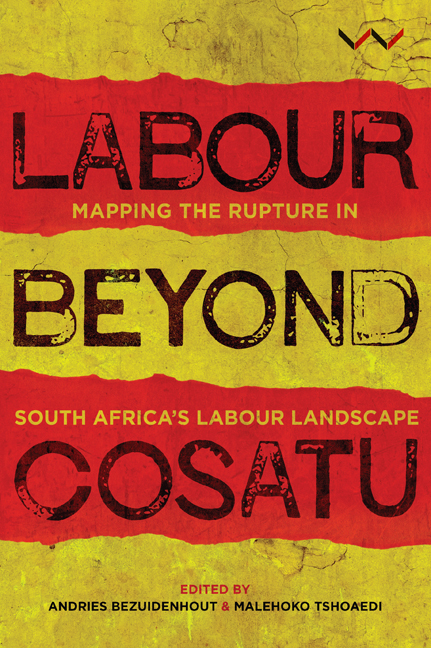Book contents
- Frontmatter
- Contents
- Figures and Tables
- Abbreviations and Acronyms
- Preface
- Chapter 1 Democracy and the Rupture in South Africa's Labour Landscape
- Chapter 2 Research in a Highly Charged Environment: Taking Democracy Seriously, 2014
- Chapter 3 The Social Character of Labour Politics
- Chapter 4 Is Cosatu Still a Working-Class Movement?
- Chapter 5 Labour Aristocracy or Marginal Labour Elite? Cosatu members' income, other sources of livelihood and household support
- Chapter 6 The Politics of Alliance and the 2014 Elections
- Chapter 7 Cosatu, Service Delivery, Civil Society and the Politics of Community
- Chapter 8 The Politics of Male Power and Privilege in Trade Unions: Understanding sexual harassment in Cosatu
- Chapter 9 Internal Democracy in Cosatu: Achievements and challenges
- Chapter 10 Public Sector Unions in Cosatu
- Chapter 11 Are Cosatu's Public Sector Unions Too Powerful?
- Chapter 12 Labour Beyond Cosatu, Other Federations and Independent Unions
- Contributors
- Index
Chapter 9 - Internal Democracy in Cosatu: Achievements and challenges
Published online by Cambridge University Press: 21 March 2018
- Frontmatter
- Contents
- Figures and Tables
- Abbreviations and Acronyms
- Preface
- Chapter 1 Democracy and the Rupture in South Africa's Labour Landscape
- Chapter 2 Research in a Highly Charged Environment: Taking Democracy Seriously, 2014
- Chapter 3 The Social Character of Labour Politics
- Chapter 4 Is Cosatu Still a Working-Class Movement?
- Chapter 5 Labour Aristocracy or Marginal Labour Elite? Cosatu members' income, other sources of livelihood and household support
- Chapter 6 The Politics of Alliance and the 2014 Elections
- Chapter 7 Cosatu, Service Delivery, Civil Society and the Politics of Community
- Chapter 8 The Politics of Male Power and Privilege in Trade Unions: Understanding sexual harassment in Cosatu
- Chapter 9 Internal Democracy in Cosatu: Achievements and challenges
- Chapter 10 Public Sector Unions in Cosatu
- Chapter 11 Are Cosatu's Public Sector Unions Too Powerful?
- Chapter 12 Labour Beyond Cosatu, Other Federations and Independent Unions
- Contributors
- Index
Summary
INTRODUCTION AND BACKGROUND
Many of the unions that came together in 1985 to form Cosatu built their power by means of democratic worker organisation (Maree 1986). The form the democracy took was by means of elected leaders who were accountable to their members. This was particularly the case at the level of the workplace, where workers elected shop stewards regularly and the shop stewards held frequent meetings with their members. The shop stewards were given mandates by their members on issues they had to take up with management, and they had to report back on the outcomes of their negotiations with management.
But this did not happen only at the level of the workplace. It was also happening at higher levels of organisation in the unions. When the Western Province General Workers’ Unions (later the General Workers’ Union) was established in 1978, it was structured in such a way that there was workers’ control of the union. The constitution laid down that a controlling committee, consisting of two elected representatives from each of the organised workplaces, took all the major policy decisions in the union. Officials in the union, including the general secretary, then had to implement policies decided by the controlling committee (Maree 1989: 134–135).
It also happened at the federal level of unions. The Trade Union Advisory and Coordinating Council (TUACC) was the forerunner of the Federation of South African Trade Unions (Fosatu) in KwaZulu-Natal. Elected representatives from the unions on the executive council of TUACC were expected to represent the interests of their union members and to report back to their unions. The reasoning behind this was very well explained by Alec Erwin, who was the first general secretary of Fosatu. In an interview in 1979 about the challenge of building democracy in the unions, he said:
We'd say you must have resilient structures that can hold people accountable in a real sense. We must establish more definite structures of accountability. So what we were trying to build in TUACC, and are presently trying to achieve in Fosatu, is that the democratic structure must be through a process of the factory controlling the shop steward because that man the worker sees every day in the plant, his access to him is far greater. […]
- Type
- Chapter
- Information
- Labour Beyond CosatuMapping the Rupture in South Africa's Labour Landscape, pp. 146 - 169Publisher: Wits University PressPrint publication year: 2017



